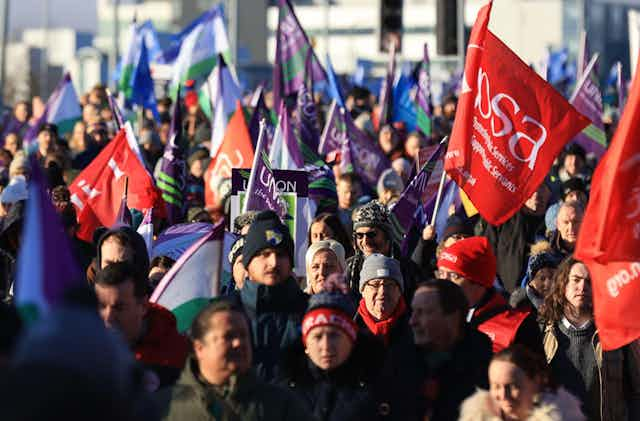An estimated 150,000 public sector workers in Northern Ireland went on strike on January 16 as part of a long-running dispute over pay and conditions. The strike, which involved workers from 16 trade unions, was the largest in more than 50 years.
Official figures show that between April 2022 and April 2023, real pay (adjusted for inflation) in Northern Ireland’s public sector fell by 7.2%. That decline came on the heels of real pay falling by more than 4% between April 2021 and April 2022, and two decades of no growth in public sector real pay.
While there is much talk about an “Irish Sea border” because of post-Brexit trade arrangements, a sea border of sorts already exists when it comes to public sector earnings. Differences in public sector pay between Northern Ireland and the rest of the UK are long-running grievances for workers.
Newly qualified teachers in Great Britain make about £30,000, while in Northern Ireland they start on £24,000. A newly qualified doctor in Northern Ireland earns a base salary of £26,000 per year. In England the starting rate is over £32,000, and in Scotland it is £31,000.
Deteriorating public services
One cannot detach the demand for higher pay from the broader economic and political malaise in which Northern Ireland finds itself.
Conservative-led austerity at the UK level introduced 1% pay caps on public sector pay increases from 2010 to 2019. And austerity budgets led to increasingly dilapidated public services. Similar to much of the rest of the UK, schools across Northern Ireland now strain to cover bills and maintain services.
Meanwhile, NHS figures from 2023 show that about 122,000 patients are awaiting surgery and a further 378,400 people are waiting to see a consultant for the first time. GP surgeries are closing in many places and there are real risks to some hospitals. Unions representing healthcare workers, the British Medical Association and Royal College of Nursing NI, have raised the alarm about the impact of underfunded services on doctor and nurse fatigue.
Making work strain and stretched resources worse still is the fact that recruitment has become a real problem, especially in education and health.
While these problems prevail across the UK, they have particularly hit Northern Ireland where public sector workers make up a greater proportion of the workforce than in the rest of the UK. The recent effects of higher inflation and rising interest rates have added to the pain.
Political issues
The strike comes amid an ongoing political crisis in the region, as the devolved administration, the Northern Ireland executive, collapsed in February 2022 and remains in a stalemate.
The unique power-sharing feature of the Stormont government means either of the two major power blocs of nationalists and unionists can prevent a functioning executive by refusing to participate. In this case, the Democratic Unionist Party (DUP) pulled out over post-Brexit trade agreements, and has refused to return until its concerns, both economic and ideological, are met.
The lack of an executive affects industrial relations, because public sector pay is a devolved matter, within the constraints of Treasury funding. If the executive was in place, ministers would receive direction from pay review bodies and set a pay policy for negotiation with the unions. In the absence of the executive, that cannot happen.
An even bigger problem, however, is the region’s public finances, itself a consequence of the inadequacies of the “Barnett Formula”, the mechanism by which the UK Treasury allocates funding to support public spending across the devolved regions. The formula, which is Treasury policy, has been assessed by the unions, among others, to be wholly inadequate in meeting Northern Ireland’s public expenditure needs.

Due to the collapse of the executive, the UK’s Northern Ireland secretary, Chris Heaton-Harris, set Northern Ireland’s budget for 2023-24, to ensure public services could continue. But perception in Northern Ireland is that Heaton-Harris set a “punishment budget” to coerce the DUP back into government. The budget requires budget overspends from past years to be paid back to the Treasury. Combined with inflation, this has meant, in real terms, funding cuts in the latest budget for education, health care, justice and economy from the previous year.
The consequences of this led the Northern Ireland department of finance – the body allocating the public sector pay pot – to claim that pay deals equivalent to those in Britain were not affordable for 2023-24.
Heaton-Harris has since indicated a willingness to remedy this should the executive return, by dangling the carrot of £3.3 billion in funds, including public sector pay awards. The money is there, and unions have called on Heaton-Harris to release it despite the lack of a functioning government at Stormont. But the hurdle remains the DUP’s unwillingness to reenter government until their concerns are addressed.
Even if such money is made available, it would be little more than a short-term sticking plaster for the region, given the ongoing economic and political issues.
Where next for the unions? At the time of writing, some remain on strike, others have promised further action, and some union officials have raised the prospect of civil disobedience. The willingness of unions to sustain action, however, looks set to be determined by the political agenda which, in the short-term, is still uncertain.

